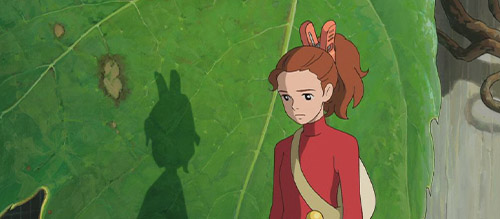Arrietty (2010) Review
Arrietty (2010)
Director: Hiromasa Yonebayashi
Screenwriters: Hayao Miyazaki, Keiko Niwa
Starring: Mirai Shida, Ryunosuke Kamiki, Shinobu Otake, Tomokazu Miura, Kirin Kiki, Keiko Takeshita
Studio Ghibli’s Arrietty (The Secret World of Arrietty in the USA) is a joy to behold. Simultaneously an affectionate and faithful adaptation of Mary Norton’s classic children’s novel “The Borrowers”, and a highly original journey in visual terms, the film captivates you from its first frame to its last.
Worlds collide when sickly teenager Shō (Ryunosuke Kamiki) moves with his aunt into a country house secretly inhabited by a family of inches-tall Borrowers. The lives of the little people taking what will not be missed by the “Human Beans” to survive changes forever when their youngest, Arrietty (Mirai Shida) is accidentally discovered by Shō on her first borrowing expedition.
Studio Ghibli is much more than just Hayao Miyazaki films. The titan studio of Japanese animation has showcased the craft of many talented animators over the years, and here it is Hiromasa Yonebayashi – also behind the studio’s swan song When Marnie Was There – in the director’s chair, with Miyazaki on co-writing duties. Much like the previous Ghibli feature Ponyo, Arrietty is sweet, tender and without any perceivable agenda beyond the environmentalist subtext the studio has become famous for. Again like Ponyo, it’s a film about growing up, finding your place in a huge and scary world and truly appreciating the importance and support of family and friends in any time of great change.
This is visually sumptuous even by Studio Ghibli’s stratospheric standards. Yonebayashi has an eye for presenting small details of his world in a big way, and every individual element is drawn and animated beautifully by his team. It’s all-too easy to get swept up in the colossal domestic and garden environments, all presented from a “Borrower’s-eye-view”. Everything feels epic and imposing, a world filled with impossible obstacles – a kitchen sideboard is a mountain, a jam jar is a prison cell. A fun game you can play with others while watching is; who can spot the most bizarre object the Borrowers are using in their day-to-day lives? At one point Borrower patriarch Pod (Tomokazu Miura) uses double-sided tape as climbing equipment; his wife Homily (Shinobu Otake) has clearly constructed their kitchen range from upturned flower pots and Arrietty has a pin as a sword at her waist and a crocodile clip tying her hair back.
The voice cast are spot-on, particularly Mirai Shida’s inquisitive and adventurous teen Borrower Arrietty and Kirin Kiki’s scheming caretaker Haru, who makes a sinister but humorous antagonist as she obsesses over capturing and removing the little home invaders. Arrietty feels like a classic Ghibli heroine like Kiki or Chihiro – strong-willed and independent but with a self-confidence that is easily knocked.
Much like in My Neighbour Totoro, for all the film’s fantasy trappings there is also an acknowledgment of the realities of the world, a common theme to explore in the magical-realist worlds of Studio Ghibli. There is a good chance that Shō could die following his imminent heart surgery, so he only has a short time to gain the trust of the Borrowers and to make sure they are safe from humans who would do them harm.
The film’s simple but effective score by Cecile Corbel rounds things off nicely, and adds a little extra magic and emotional connectivity to proceedings. The film feels a touch over-long but I think that’s more to do with how every small aspect of this story’s world feels big, insurmountable for the pint-sized protagonists. The world is bigger to them so their story feels longer.
Arrietty is a great animation for all ages. In a really quite horrifying modern world, it makes a nice change to watch something that is so innocent, that would satisfy a 5 year-old or an 85 year-old in equal measure. So next time you’re tidying your house or clearing up your garden maybe leave a few things around for the unseen little people to use.
[Hang on a minute, have I just paraphrased the theme tune to “The Wombles”?]
22/24


